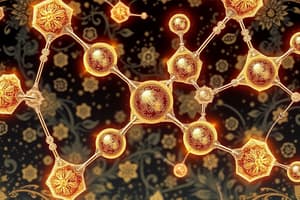Podcast
Questions and Answers
What is the primary factor in determining the polarity of a bond?
What is the primary factor in determining the polarity of a bond?
- Valence electrons
- Electronegativity (correct)
- Atomic radius
- Ionization energy
Alkenes are a type of functional group.
Alkenes are a type of functional group.
False (B)
What is the name of the rule that states an atom tends to gain, lose, or share electrons to achieve a full outer energy level?
What is the name of the rule that states an atom tends to gain, lose, or share electrons to achieve a full outer energy level?
Octet rule
The shape of a molecule is determined by its ______________________.
The shape of a molecule is determined by its ______________________.
Match the following functional groups with their corresponding structures:
Match the following functional groups with their corresponding structures:
Phenols belong to the classes of alcohol.
Phenols belong to the classes of alcohol.
What is the name of the concept that describes the difference in solubility between hydrocarbons and alcohols?
What is the name of the concept that describes the difference in solubility between hydrocarbons and alcohols?
In resonance, a ______________________ arrow is used to indicate electron flow.
In resonance, a ______________________ arrow is used to indicate electron flow.
What is the term used to describe the distribution of electrons within an atom or molecule?
What is the term used to describe the distribution of electrons within an atom or molecule?
Isomers are a type of functional group.
Isomers are a type of functional group.
What is the difference between a primary and tertiary alcohol?
What is the difference between a primary and tertiary alcohol?
The shape of a molecule is determined by its ________________.
The shape of a molecule is determined by its ________________.
Which of the following is NOT a type of intermolecular force?
Which of the following is NOT a type of intermolecular force?
Match the following functional groups with their corresponding structures:
Match the following functional groups with their corresponding structures:
Cyclo compounds can be named using the same rules as alkanes.
Cyclo compounds can be named using the same rules as alkanes.
What is the difference between solubility of hydrocarbons and alcohols?
What is the difference between solubility of hydrocarbons and alcohols?
The ________________ rule states that an atom tends to gain, lose, or share electrons to achieve a full outer energy level.
The ________________ rule states that an atom tends to gain, lose, or share electrons to achieve a full outer energy level.
Which of the following is an example of an alkyl substituent?
Which of the following is an example of an alkyl substituent?
Flashcards are hidden until you start studying
Study Notes
Structure and Bonding
- Electron configuration and orbital diagrams are essential for understanding atoms, cations, and anions.
- Polarity of bonds and molecules depends on electronegativity and dipole moment.
- Formal charge, octet rule, and counting lone pairs on an atom are crucial for understanding bonding.
- Shape of molecules and hybridization are essential for writing bonding schemes.
- Intra- and intermolecular forces are important for understanding molecular interactions.
Drawing Structures
- Condensed structures can be converted to line bond (skeletal) structures.
- Line bond structures can be converted to condensed structures.
- Determining molecular formulas involves identifying and counting 1o, 2o, and 3o carbons and hydrogens, O, N, halides (Cl, Br).
- Alcohols can be classified as primary, secondary, and tertiary, noting that phenols do not belong to these classes.
Functional Groups
- Identifying functional groups includes alkenes, alcohols, aldehydes, ketones, carboxylic acids, esters, ethers, amines, amides, thiol, disulfides, and nitriles from given structures.
Reactions and Naming Compounds
- Types of reactions include acid-base reactions.
- Naming compounds involves naming alkanes, alkenes, alcohols (aldehydes, ketones, esters, carboxylic acids, etc.).
- Isomers can be structural (constitutional) and geometric (cis-trans) in alkenes and cyclic alkanes.
- Naming cyclo compounds involves recognizing specific structures.
Properties of Compounds
- Solubility of hydrocarbons (alkanes, alkenes, benzene) differs from that of alcohols and carboxylic acids.
- Boiling points of hydrocarbons (alkanes, alkenes, benzene) differ from those of alcohols.
- Density concepts are based on structures of alkanes and water.
Structures of Alkyl Substituents
- Sec-butyl, tert-butyl, isopropyl, and other alkyl substituents have specific structures.
Resonance
- Push arrows can be used to identify resonance in alkenes, carbonyl groups, carboxylic acids, amines, etc.
- Identifying most significant and least significant structures is important in resonance.
Acid-Base Reaction
- Identifying structures as acid or base is crucial.
- Increasing order of acidity can be determined using CARDIO and pKa.
- C-charge on atom, A-atom, R-resonance, DI-dipole induction, and O-orbitals (sp, sp2, sp3) are important concepts in acid-base reactions.
Spectroscopy
- Infrared spectroscopy (IR) involves identifying bands based on functional groups.
- Determining and calculating degree of unsaturation using HDI is important in IR spectroscopy.
- 1H NMR spectroscopy involves recognizing splitting patterns and counting proton signals.
Structure and Bonding
- Electron configuration and orbital diagrams are essential for understanding atoms, cations, and anions.
- Polarity of bonds and molecules depends on electronegativity and dipole moment.
- Formal charge, octet rule, and counting lone pairs on an atom are crucial for understanding bonding.
- Shape of molecules and hybridization are essential for writing bonding schemes.
- Intra- and intermolecular forces are important for understanding molecular interactions.
Drawing Structures
- Condensed structures can be converted to line bond (skeletal) structures.
- Line bond structures can be converted to condensed structures.
- Determining molecular formulas involves identifying and counting 1o, 2o, and 3o carbons and hydrogens, O, N, halides (Cl, Br).
- Alcohols can be classified as primary, secondary, and tertiary, noting that phenols do not belong to these classes.
Functional Groups
- Identifying functional groups includes alkenes, alcohols, aldehydes, ketones, carboxylic acids, esters, ethers, amines, amides, thiol, disulfides, and nitriles from given structures.
Reactions and Naming Compounds
- Types of reactions include acid-base reactions.
- Naming compounds involves naming alkanes, alkenes, alcohols (aldehydes, ketones, esters, carboxylic acids, etc.).
- Isomers can be structural (constitutional) and geometric (cis-trans) in alkenes and cyclic alkanes.
- Naming cyclo compounds involves recognizing specific structures.
Properties of Compounds
- Solubility of hydrocarbons (alkanes, alkenes, benzene) differs from that of alcohols and carboxylic acids.
- Boiling points of hydrocarbons (alkanes, alkenes, benzene) differ from those of alcohols.
- Density concepts are based on structures of alkanes and water.
Structures of Alkyl Substituents
- Sec-butyl, tert-butyl, isopropyl, and other alkyl substituents have specific structures.
Resonance
- Push arrows can be used to identify resonance in alkenes, carbonyl groups, carboxylic acids, amines, etc.
- Identifying most significant and least significant structures is important in resonance.
Acid-Base Reaction
- Identifying structures as acid or base is crucial.
- Increasing order of acidity can be determined using CARDIO and pKa.
- C-charge on atom, A-atom, R-resonance, DI-dipole induction, and O-orbitals (sp, sp2, sp3) are important concepts in acid-base reactions.
Spectroscopy
- Infrared spectroscopy (IR) involves identifying bands based on functional groups.
- Determining and calculating degree of unsaturation using HDI is important in IR spectroscopy.
- 1H NMR spectroscopy involves recognizing splitting patterns and counting proton signals.
Studying That Suits You
Use AI to generate personalized quizzes and flashcards to suit your learning preferences.




